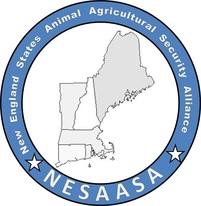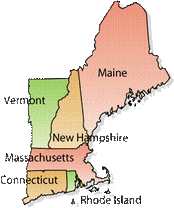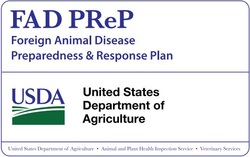New England Secure Milk Supply (SMS) Plan – in DRAFT
- Plan for Milk Movement During a FMD Outbreak (September 1, 2015)
- MOU on the New England SMS Plan (signed by the six states, June 3, 2014)
Attachments – also in DRAFT
1. Notifications and Public Information
2. Job Aids
- 2.01 How to Reduce Risks to Your Farm
- 2.02 How to Spot Clinical Signs of FMD
- 2.03 How to Conduct Active Observational Surveillance: A Guide for Herd Health Monitors
- 2.04 How to Increase Farm Biosecurity - On-line Support
- 2.05 How to Protect Farm Employees During a FMD Outbreak
- 2.06 How Drivers Can Reduce the Risk of Spreading Infection
- 2.07 How to Wash the Exterior of a Milk Tanker
- 2.08 How to Clean and Disinfect FMD Virus
- 2.09 How to Use Boot Baths
- 2.10 How to Communicate with Dairy Consumers about FMD
and Commercial Tank Cleaning Directory (Bulk Transporter)
3. Forms
- 3.1 Visitor Log
- 3.2 Vehicle Entry Log
- 3.3 Cleaning and Disinfection Checklist
- 3.4 Tanker Exterior Cleaning Certificate
- 3.5 Herd Monitoring Daily Log
- 3.6 Epidemiological Investigation Questionnaire
- 3.7 Message Map Template for Risk Communication
- 3.8 Initial Permit for Movement of Unpasteurized Milk from Farm to Processing Plant
- 4.01 Sign - Stop at Main Gate - Bilingual (English and Spanish)
- 4.02 Emergency Disease Prevention Measures in Effect - Bilingual (English and Spanish)
- 4.03 No Trespassing
- 4.04 Farm Visitor Policy - English or Spanish
- 4,05 Honk to Announce Arrival Before Exiting - English or Spanish
- 4.06 Check-in - English or Spanish
- 4.07 Authorized Personnel Only - English or Spanish
- 4.08 Do Not Enter - English or Spanish
- 4.09 Policies for Visitors Contacting Animals - English or Spanish
- 4.10 Protective Clothing Required - English or Spanish
5. Guides for Response to FMD on Farms
- 5.2 To Do List - Go Guide
- 5.1 If you see . . . Poster - Bilingual (English and Spanish)
- 5.3 FMD Response Package - English or Spanish
- 5.4 Fast Facts about FMD
- 5.3 Fact Sheet for Livestock Specialists - English or Spanish
- 5.5 Inactivation of Foot-and-Mouth Disease Virus in Milk Products
- 5.6 Disease Images
- 5.7 Dairy Farm FMD Emergency Response Plan (ERP)
- 5.8 Legend and Sample Map for Dairy Farm ERP
- 6.2 SMS Plan Components, including:
- Biosecurity Performance Standards (BPS) for Raw Milk Collection and Transport
- Active Observational Surveillance (AOS) to Support Permitting Milk Transport
- Milk Handling from FMD Infected, Suspect, or Contact Dairies
- Approved Disinfectants - 6.1 Foot-and-Mouth Disease Information and Links
7.1 The Red Book - the USDA Foot-and-Mouth Disease Response Plan (September 2014)
7.2 NAHEMS Guidelines
7.3 FAD PReP Ready Reference Guides
7.4 FMD Materials
7.2 NAHEMS Guidelines
- 7.2.01 Continuity of Business
- 7.2.02 Biosecurity
- 7.2.03 Quarantine and Movement Control
- 7.2.04 Information Management
- 7.2.05 Cleaning and Disinfection
- 7.2.06 Disposal
- 7.2.07 Surveillance, Epidemiology, and Tracing
- 7.2.08 Health and Safety
- 7.2.09 Personal Protective Equipment (PPE)
- 7.2.10 Mass Depopulation and Euthanasia
- 7.2.11 Vaccination for Contagious Diseases
Appendix A: Vaccination for Foot-and-Mouth Disease
7.3 FAD PReP Ready Reference Guides
- 7.3.01 Understanding FMD Response Strategies
- 7.3.02 Communications
- 7.3.03 Zones, Areas, and Premises in an FAD Outbreak
- 7.3.04 Critical Activities and Tools during an FAD Response
- 7.3.05 Movement Control in an FAD Outbreak
- 7.3.06 Overview of the FMD Response Plan (The Red Book)
- 7.3.07 Overview of Emergency Vaccination
- 7.3.08 Overview of FMD Vaccination Issues
- 7.3.09 Overview of FMD Freedom and Vaccination
- 7.3.10 Quarantine, Movement Control, and Continuity of Business
- 7.3.11 FMD Surveillance
- 7.3.12 Overview of FMD Diagnostics
- 7.3.13 Etiology and Ecology of FMD
- 7.3.14 Common Operating Picture
- 7.3.15 Comparing US and UK FMD Response Planning
- 7.3.16 Additional FMD References
7.4 FMD Materials
8. International Standards from the World Organisation for Animal Health (OIE)
- 8.1 Dairy Processing Standards to Deactivate FMDV - Articles 8.7.38 and 8.7.39 of the Terrestrial Animal Health Code (2014)
- 8,2 Foot and Mouth Disease - Chapter 8.7 of the Terrestrial Animal Health Code (2014)
- 8.3 Foot and Mouth Disease - Chapter 2.1.5 of the Manual of Diagnostic Tests and Vaccines for Terrestrial Animals (2014)
9. Resources for Assessing "Readiness" for Emergency Milk Movement from NESAASA
9.1 Producers
9.2 Processors
9.3 Haulers
- 9.1.1 Producer Survey
- 9.1.2 Cover Letter for Producer Survey
- 9.1.3 Answers to Producers' Frequently Asked Questions
- 9.1.4 Reminder for Producers Who Have Not Yet Responded
- 9.1.5 Model for Rating Producer Readiness
- 9.1.6 Raw Scores for Producer Survey
- 9.1.7 Weighted Criteria for Rating Producer Readiness
- 9.1.8 Readiness of New England Dairy Farms for SMS: A Snapshot, 2014
9.2 Processors
9.3 Haulers
- 9.3.1 Hauler Survey
- 9.3.2 Cover Letter for Hauler Survey
Richard P. Horwitz, Consultant to NESAASA and USDA-APHIS, 2010-2017






